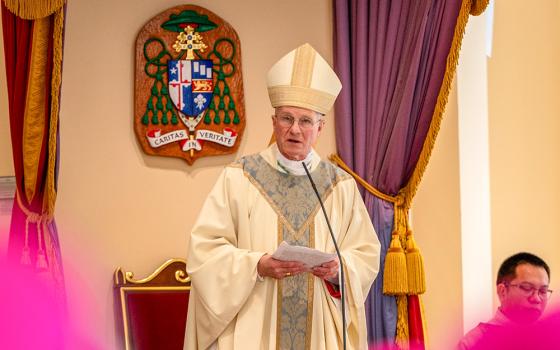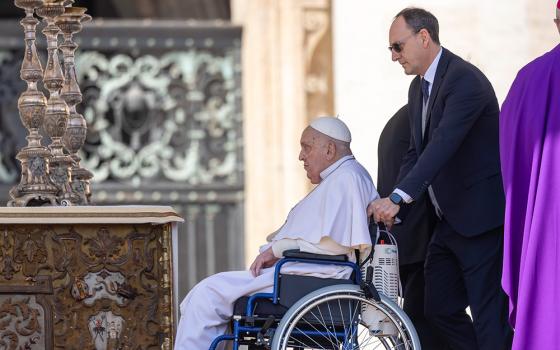
The "100 Leaders for 100% Clean Energy" rally on June 9, 2021, brought together leaders of various faith traditions in support of establishing a national clean energy standard as part of President Joe Biden's proposed $2 trillion infrastructure plan. (Courtesy of Interfaith Power & Light)
Interfaith Power and Light, one of the most prominent U.S. faith-based environmental networks, has shuttered its national office amid financial troubles, its board of directors announced in late January.
The abrupt suspension of national operations amid a funding shortfall comes at a precarious moment, as an energized Trump administration has sought to quickly expunge climate and environmental justice efforts throughout the federal government, and as signs of climate change rage in California and across the country.
Leaders within Interfaith Power and Light said their work as a top moral voice on environmental matters will continue despite the current climate through its 40 state and regional affiliates, which are independent entities each with their own leadership, staff and fundraising.
The closure was a shock, even to board members. "It was sudden and painful," said Rabbi Fred Scherlinder Dobb, a board member and chair of the National Coalition on the Environment and Jewish Life.
For more than two decades, Interfaith Power and Light has been a leader in galvanizing a faith voice around climate change and environmental justice. It has mobilized religious communities and houses of worship across the country to adopt solar power and take other energy-saving steps; to support federal regulations and legislation around climate and clean air and water; to oppose fossil fuel projects and financing; and to inform and register voters. It also hosted an annual Faith Climate Action Week.
In a Jan. 23 statement, the Interfaith Power and Light board called the move to suspend the national office, which went into effect Jan. 17, a "difficult decision."
"Despite the unwavering passion and commitment of our staff, partners, and supporters, the national NGO, that offered logistical and other support to the network of IPL affiliates, faced financial challenges that it was unable to overcome — even as the impact of the network as a whole came to be ever more centered in the affiliates," the board said.
Closure of the national office impacted eight staff members. In addition, the Rev. Susan Hendershot, who led the national Interfaith Power and Light as president for seven years, left her position Jan. 15 after announcing her departure in mid-December. Hendershot declined to comment.
Advertisement
Scherlinder Dobb, the Interfaith Power and Light board member, told EarthBeat the decision to suspend national operations came after Hendershot left, and that talks about that possibility began just a week earlier.
A board review of finances at that time revealed a "short-term crunch" in funding, one severe enough it wouldn't be able to pay staff.
"Honestly, there was no talk of closure before that. It was sudden and painful," Scherlinder Dobb said.
At the heart of the financial shortfall was back-to-back years of deficits totaling hundreds of thousands of dollars.
In its 2023 tax filings, under the name The Regeneration Project, Interfaith Power and Light reported a $802,168 gap between revenue and expenses. That was driven mainly by a nearly $860,000 decline in funding from 2022 combined with a $236,000 rise in payroll expenses. 2024 tax returns have not been filed, but Scherlinder Dobb said the ongoing financial review indicated another deficit "well into the six figures."
While the national Interfaith Power and Light nonprofit had prior years of both six-figure net negative and positive incomes — with a peak of $1.3 million in the black in 2015 — the two consecutive deficit years strained operations. Expectations in mid-December for new grant funding to arrive to cover payroll in the near term proved overly optimistic given the gap, Scherlinder Dobb said.
"We've always had ebb and flow. We never quite got to boom or bust. And that's the subtle line that we crossed early this year," he said.
What led to that point, the rabbi said, was a combination of staff expansion and fundraising falling below expectations — a trend numerous nonprofits have faced in recent years. Less a factor, he said, was the national office's move in 2023 from Oakland, California, to Washington, D.C., where it took residence in the 100-year-old National Methodist Building across from the U.S. Supreme Court and the U.S. Capitol. The space, offering a breathtaking view of the Capitol from its fourth-floor conference room, lowered office expenses compared to Oakland, Scherlinder Dobb said.

Faith leaders form a prayer circle inside the office of Minnesota Gov. Tim Walz as part of an action opposing the Enbridge Line 3 pipeline in February 2020. (Minnesota Interfaith Power & Light)
With the national office closed, Interfaith Power and Light will shift its focus to amplifying its network of state-based satellite organizations. "IPL state and regional affiliates across the country have been, and continue to, mobilize people of faith and conscience into action," the board statement said.
"We are letting those local leaders lead," Scherlinder Dobb told EarthBeat. "And they will either continue with the national NGO in some revised capacity, or take its functions and divide responsibilities and meet the needs across the affiliates."
Those decisions — including if a national office is revived in some form and how to continue many of Interfaith Power and Light's national programs — have been tasked to a network steering committee, which has operated for years.
Katie Ruth, executive director of Pennsylvania Interfaith Power and Light and a member of the steering committee, said there's "certainly a lot of grief in this transition." But Rice and other state affiliates, which together have staff 10 times the national office, also see potential and opportunity to create a new shared leadership model.
"Our strength is in the people who power our movement from the ground up. That's always been true, and I think that's true now more than ever," Ruth said.
Founded in 2000, Interfaith Power and Light grew from the work of Episcopal congregations in California in the 1990s. It was there, along with Massachusetts, where the first state affiliates formed.
Its national outreach grew in 2006 as it hosted screenings of Al Gore's documentary "An Inconvenient Truth." The Cool Congregations program has encouraged faith efforts to reduce their greenhouse gas emissions and presented awards around energy, conservation and carbon neutrality. All Saints Catholic Church, in Syracuse, New York, was among the 2024 honorees.
In election years, Interfaith Power and Light has provided environmental voter guides and its members have taken part in voter outreach and registration drives. It has been active in lobbying Congress alongside other faith groups, and a recent campaign sought to urge U.S. automakers to build affordable electric vehicles.
Internationally, Interfaith Power and Light members attended United Nations summits on climate change and biodiversity as well as gatherings of faith leaders on ecological matters.
In recent years, the national staff has focused on informing houses of worship on ways to tap into tax incentives and other federal grants for renewable energy and energy efficiency available under the Inflation Reduction Act — at $360-plus billion, the nation's largest climate investment. Interfaith Power and Light lobbied aggressively for the bill's passage, and later hosted a webinar with Energy Secretary Jennifer Granholm. Hendershot was a member of the president's White House Environmental Justice Advisory Council.
The ability to coordinate state Interfaith Power and Light organizations around federal environmental regulations or bills in Congress was one of the advantages of a national office, said Matt Russell, who succeeded Hendershot as executive director of Iowa Interfaith Power and Light before leaving that position himself to join the U.S. Department of Agriculture under the Biden administration.
"That was one of the real values that I saw," he told EarthBeat.
Michele Dunne, executive director of Franciscan Action Network, which is located in D.C., called the national IPL office "a strong presence in faith-based advocacy on the environment." She said the Franciscan public policy organization will continue to partner with IPL's state affiliates.
The pivot from Biden — the nation's second Catholic president who discussed climate change in conversations with Pope Francis — to Donald Trump — who has vowed to expand U.S. fossil fuel production, curtail electric vehicle expansion and already moved to exit the Paris Agreement — has many environmental organizations bracing for a challenging four years ahead.

Matt Russell talks with Tom Vilsack, center, secretary of agriculture under President Barack Obama, and his neighbor and fellow farmer Justin Jordan, left. (Provided photo)
Scherlinder Dobb said while Interfaith Power and Light holds "deep concern" around Trump's environmental rollbacks, his return to the White House didn't influence the decision to close the national office, including any potential loss in federal funding. Its 2023 tax filings showed government grants of $160,849, compared to $1.4 million in gifts and foundation grants.
The D.C.-based rabbi expressed confidence that Interfaith Power and Light will retain its voice on the national scene as Trump attempts to unwind environmental and climate progress.
"The people doing the work of environmental justice have not gone and are not going anywhere," he said. "Much of the advocacy work was already being led from the state affiliates working both on their share of the federal puzzle as well as individual state initiatives."
Looking ahead, the national Interfaith Power and Light board will remain, as will the main website. Board members have also worked to find new employment for national staff. In its statement, the board expressed hope that the foundation built over the past two decades "will continue to serve as a catalyst for progress."
"Our faith traditions and spiritual practices call us together in the shared belief that we must care for this planet and for those most impacted by the climate crisis," it said. "The work continues on across this network and within each of us."
Said Ruth, "There is already good work happening on the ground in a community that's not going anywhere. And as much as this network can, it will continue to be a place for folks who are looking to work at the intersection of faith and climate and environment."






